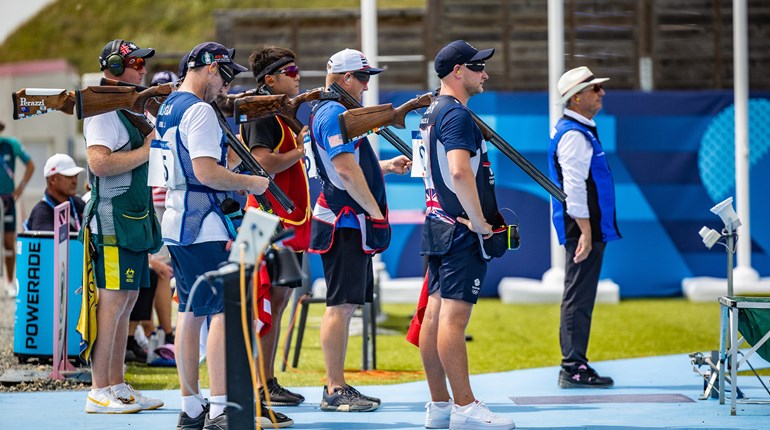In addition to the three fundamental Rules for Safe Gun Handling, you need to observe a number of additional rules when you use or store your firearm. Watch the video above.
Know your target and what is beyond.
Whether you are at the range, in the woods, or in a self-defense situation, if you're going to shoot you must know what lies beyond your target. In almost all cases, you must be sure that there is something that will serve as a backstop to capture bullets that miss or go through the target. Even in an emergency, you must never fire in a direction in which there are innocent people or any other potential for mishap. Think fire, shoot second.

Know how to use the gun safely.
Before handling a gun, learn how it operates. Read the owner's manual for your gun. Check the manufacturer's website for an owner's manual if you do not have one. Know your gun's basic parts, how to safely open and close the action, and how to remove ammunition from the gun. No matter how much you know about guns, you must always take the time to learn the proper way to operate any new or unfamiliar firearm. Never assume that because one gun resembles another, they both operate similarly. Also, remember that a gun's mechanical safety is never foolproof. Guidance in safe gun operation should be obtained from the owner's manual or a qualified firearm instructor or gunsmith.

Knowing how to use the gun safely is especially important with pistols, as there are many different types of pistol mechanisms, each with its own specific operating procedure. Most long guns of a particular type (such as bolt-action rifles or pump-action shotguns) work in essentially the same way, allowing an individual familiar with one model to be likely to know how to operate another of the same type. This cannot always be said of pistols, particularly semi-automatic pistols.
Be sure your gun is safe to operate.
Just like other tools, guns need regular maintenance. Proper cleaning and storage are a part of the gun's general upkeep. If there is any question regarding a gun's ability to function, it should be examined by a knowledgable gunsmith. Proper maintenance procedures are found in your owner's manual.

Use only the correct ammunition for your gun.
Each firearm is intended for use with a specific cartridge. Only cartridges designed for a particular gun can be fired safely in that gun. Most guns have the ammunition type stamped on the barrel and/or slide. The owner's manual will also list the cartridge (or cartridges) appropriate for your gun. Ammunition can be identified by information printed on the cartridge box and usually stamped on the cartridge head. Do not shoot the gun unless you absolutely know you have the proper ammunition.
Using only the correct ammunition for your gun is of special importance with pistols, as there are some pistol cartridges that have several names. Moreover, there are a number of different cartridges which have the same external dimensions, and thus fit in the same firearm chamber, but produce strikingly different operating pressures. Furthermore, even for the same cartridge there may be loading having varying levels of pressure and performance. These higher-pressure loads must be used only in a firearm designed for them.
Wear eye and ear protection.
The sound of a gunshot can damage unprotected ears. Gun discharges can also emit debris and hot gas that could cause eye injury. Thus, both eye and ear protection are highly recommended whenever you are firing live ammunition in your gun. Safety glasses and ear plugs or muffs should also be worn by any spectators or shooting partners present during live-fire sessions.

Never use alcohol or drugs before or while shooting.
Alcohol and many drugs can impair normal mental and physical bodily functions, sharply diminishing your ability to use a gun safely. These substances must never be used before or while handling or shooting guns.
Note that these effects are produced not just by illegal or prescription drugs. Many over-the-counter medications also have considerable side effects which may be multiplied when certain drugs are taken together or with alcohol. Read the label of any medication you take, even common non-prescription medications, or consult your physician or pharmacist for possible side effects. If the label advises against driving or operating equipment while taking the medication, you should also avoid using a firearm while taking it.
Store guns so they are inaccessible to unauthorized persons.
It is your responsibility as a gun owner to take reasonable steps to prevent unauthorized persons (especially children) from handling or otherwise having access to your firearms. You have a number of options for safely accomplishing this. The particular storage method you choose will be based upon your own particular home situation and security needs.

Be aware that certain types of guns and many shooting activities require additional safety precautions.
There are many different types of firearms, some of which require additional safety rules or procedures for proper operation. These are commonly found in your firearm's owner's manual. Also, most sport shooting activities have developed sets of rules to ensure safety during competition. These rules are generally sport-specific; the procedures for loading your firearm and commencing fire, for example, are different in NRA Bullseye shooting than in NRA Action Pistol competition.
See more: 5 Common Mistakes To Avoid At Your First Service Rifle Match























